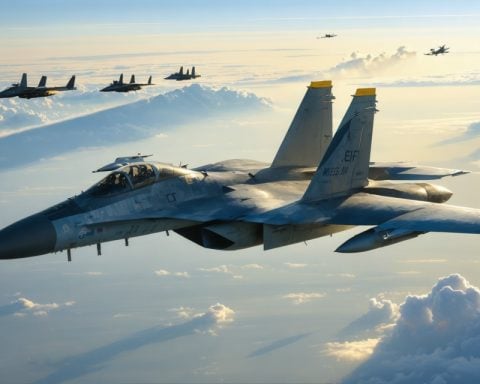- Iran is keen on acquiring the Su-35 fighter jet from Russia to modernize its outdated air fleet from the Cold War era.
- The Su-35, despite underperformance in Ukraine, is coveted for its advanced 4.5-generation capabilities, potentially enhancing Iran’s regional air superiority.
- The transaction remains unconfirmed, with Russia and Iran’s growing alliance raising concerns in Western nations about stability in the region.
- Russia seeks to deepen ties with Iran as international sanctions isolate Moscow post-Ukraine conflict, demonstrated by a January pact hinting at possible weapon exchanges.
- Critics question whether the Su-35 sale will actually materialize, citing past unfulfilled promises from Iran regarding military advancements.
As the horizon glows with geopolitical uncertainty, Iran sets its sights on the Su-35, Russia’s enigmatic fighter jet, which promises to replace its aging fleet of Cold War relics. Despite the Su-35’s lackluster battlefield performance in Ukraine, Tehran’s desire burns brightly, driven by machines that once reigned supreme in the 1970s.
Rumblings from Tehran hinted at acquiring these agile 4.5-generation jets, though the Kremlin remains tight-lipped about any finalized transaction. Analysts speculate a deepening bond between Moscow and Tehran—a partnership nourished by strategic necessity. Iran feeds the Russian drone war machine over Ukraine; Russia, in turn, may lend wings to Iran’s ambitions. The prospect alarms Western powers, sketching a possible axis that could disrupt the region’s balance.
For Moscow, diplomacy dances with necessity. Battered by international sanctions and global hesitation since the Ukraine conflict erupted in 2022, Russia seeks allies in unexpected quarters. Mirroring each other’s disdain for the West, Iran and Russia find common ground. A January pact between their leaders hinted at a broader alliance—one that potentially includes a delivery of the Su-35.
Slicing through the skies, the Su-35 derives its form from the Cold War’s fiery crucible. Equipped with canards and twin-engine power, it promises speed and stealth reminiscent of an F-22 Raptor, while its arsenal of missiles could transform Iran’s grip on regional air superiority.
Yet, skepticism lingers. Past exaggerations from Iranian officials often painted pictures of power unfulfilled. Whether the Su-35 will truly join Iran’s ranks remains cloaked in uncertainty. However, if delivered, these jets would propel Iran’s air force into a new era.
Could Iran’s Acquisition of the Russian Su-35 Change the Balance of Power in the Middle East?
The Potential Impact of Iran Acquiring the Su-35
The Su-35, a formidable fighter jet developed by Russia, represents a significant upgrade for Iran’s air force, which largely relies on outdated aircraft originally acquired during the Cold War. The potential acquisition of these advanced jets could alter military dynamics in the Middle East, posing new challenges for Iran’s regional adversaries and marking a significant enhancement of Iran’s military capabilities.
Features, Specs & Pricing
Features and Specs:
– Avionics and Radar Systems: The Su-35 is equipped with the Irbis-E passive electronically scanned array radar and a sophisticated electronic warfare suite, enhancing its ability to detect and engage targets over a range of several hundred kilometers.
– Engine and Performance: It boasts two AL-41F1S engines, granting supermaneuverability that allows it to evade enemy fire and perform complex dogfights.
– Armament: The jet can be armed with a variety of air-to-air and air-to-ground missiles, including the advanced R-77 air-to-air missile.
Pricing:
– While precise figures are variable and dependent on negotiations and included systems, the Su-35’s estimated unit cost is approximately $40-65 million USD, depending on the contract details.
Real-World Use Cases
Iran’s acquisition of the Su-35 could bolster its capacity in various military scenarios:
– Air Superiority Missions: Enhancing the Iranian air force’s ability to dominate the skies, deterring adversaries in aerial conflicts.
– Strategic Deterrence: With an increased fleet of advanced jets, Iran could more effectively project power, potentially discouraging preemptive strikes by regional rivals like Israel or Saudi Arabia.
Pros & Cons Overview
Pros:
– Enhanced Air Combat Capability: The Su-35 could give Iran a qualitative edge against most regional air forces.
– Strategic Leverage: Strengthened aerial capabilities might extend Iran’s influence in the Middle Eastern theater.
Cons:
– Cost and Maintenance: Maintaining such advanced technology requires significant investment, expertise, and infrastructure.
– International Isolation: The acquisition may lead to further sanctions or diplomatic isolation from Western nations.
Geopolitical Analysis and Industry Trends
Geopolitical Implications:
– Russian-Iranian Alliance: Strengthening military ties could lead to more cooperation in other areas, such as energy and defense technologies, concerning Western countries.
– Regional Power Shifts: Neighboring countries may seek to counterbalance Iran’s elevated military capability, potentially leading to an arms race in the region.
Industry Trends:
– Increased Demand for Advanced Fighters: With the unveiling of advancements in fighter technology, countries with tense regional relationships are increasingly vying for superior air power.
Controversies & Limitations
Some experts remain skeptical about the efficacy of the Su-35, especially given its proclaimed shortcomings in the Ukraine conflict—such as vulnerability to modern air defense systems. Moreover, the absence of a confirmed contract raises questions about the reality of this acquisition.
Conclusion and Actionable Recommendations
While the acquisition of the Su-35 by Iran remains a complex geopolitical issue, individuals and governments alike should monitor developments and assess regional security dynamics accordingly. For policymakers, engaging in diplomatic dialogue and reinforcing defense partnerships may be prudent steps.
Quick Tips for Readers:
– Stay informed on regional developments through credible international news platforms.
– Consider the broader implications of military acquisitions on global security.
– Engage with expert analysis to understand the nuances of defense technology.
For more on global defense and aviation trends, visit Aviation Week.








